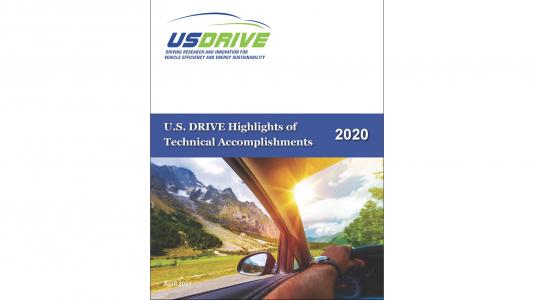
U.S. DRIVE (Driving Research and Innovation for Vehicle efficiency and Energy sustainability) is a voluntary government-industry partnership focused on advanced automotive and related energy infrastructure technology research and development (R&D). Specifically, the Partnership facilitates precompetitive technical information exchange among experts who interact as equal partners to discuss R&D needs, develop joint goals and technology roadmaps, and evaluate R&D progress. U.S. DRIVE’s goal is to accelerate the development of pre-competitive, innovative, and affordable technologies to enable a full range of efficient and clean advanced light-duty vehicles as well as related energy infrastructure.
Each year, the Partnership selects technical highlights from hundreds of DOE-funded projects. The resulting Highlights of Technical Accomplishments Report includes one-page summaries that represent what DOE and the automotive, energy, and electric utility industry partners collectively consider to be significant progress in the development of advanced automotive and infrastructure technologies.
The 2020 report includes three highlights from Argonne.
Direct Numerical Simulation of Flow and Heat Transfer in Internal Combustion Engines
Researchers at Argonne National Laboratory recently performed the first ever direct numerical simulations of the compression and expansion strokes of the GM TCC-III engine at motored operating conditions. These simulations, performed with the open-source Nek5000 code using more than 400 million gridpoints on more than 50,000 processors of Argonne’s Theta supercomputer, have delivered insights into the turbulent flow-field and near-wall heat transfer characteristics in an internal combustion engine. The data generated from these simulations can lead to significantly improved understanding of in-cylinder processes and accurate models for engineering simulations.
Machine Learning Tool and Model Link Injector Wear with Reduced Performance
To comply with regulation standards, direct injection engines have steadily increased injection pressure. However, these conditions can lead to erosion in fuel injectors and reduce performance. Using in-situ x-ray imaging plus a new deep learning approach, Argonne researchers developed the cavitation-induced erosion risk assessment (CIERA) toolkit to predict the locations of cavitation and erosion in multi-hole injectors. Using this toolkit, engine manufacturers can gain a clear view of the long-term performance of injectors and optimize their engine designs for the lifetime of the vehicle.
CFD Simulations Provide New Insights into Pre-Spark Heat Release in Boosted DISI Engines
Accurate capture of low-temperature heat release is critical for predicting auto-ignition processes in internal combustion engines, and extremely late ignition phasing can lead to low-temperature heat release prior to the spark, i.e., the pre-spark heat release associated with engine knock. By developing a set of best practices on how to capture the kinetic phenomena leading to knock under boosted direct-injection spark-ignited operating conditions, Argonne researchers provided another step forward towards predictive simulations of knock in internal combustion engines.